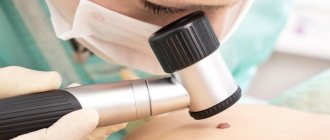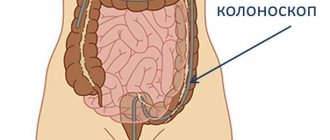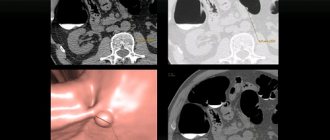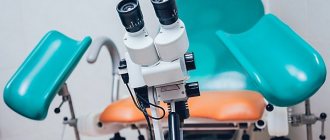the whole list
The presence of contraindications should be checked with a doctor.
If the preparation is carried out using the drug “Fortrans”, there is no need for cleansing enemas. 2 days before the colonoscopy, you need to switch to a special (slag-free) diet, excluding vegetables and fruits, potatoes, herbs, berries, mushrooms, legumes, and black bread from the diet. Allowed: broth, semolina porridge, egg, boiled meat, boiled sausage, fish, cheese, butter, fermented milk products, except cottage cheese.
It is advisable to start taking the Fortrans solution no earlier than 2 hours after eating. For effective preparation, you need to purchase 3 or 4 packages of the drug at the pharmacy. Four packages must be purchased for those patients who have a large body size, constipation, adhesive disease of the abdominal cavity, previously identified lengthening or prolapse of the colon (during the passage of barium through the intestines, irrigation or colonoscopy).
If the colonoscopy is planned from 8:00 to 14:00
On the eve of the study, you can have a light lunch, no later than 13:00, and it is better not to have dinner. Dissolve the contents of each Fortrans package in 1 liter of high-quality drinking water at room temperature. From 15:00 to 19:00 on the eve of the study, you need to drink 3-4 liters of Fortrans solution, no more than ¼ cup. If you try to drink it quickly, the cleansing of the intestines will be incomplete (the solution will come out quickly and will not have time to mix sufficiently with the contents of the intestines).
With rapid use, there is also a high probability of side effects in the form of nausea and vomiting. To make it easier to tolerate the taste of Fortrans, it is better to eat it with lemon, orange or any fruit (preferably sour), but without seeds, which may remain in the intestines. If necessary, lemon juice can be added to the solution to improve the taste. People who are sensitive to taking large volumes of liquid (nausea, belching, etc.) are recommended to take 1 tablet of Motilium 1 hour before the start of preparation.
Approximately 1.5–2 hours after taking the first liter of Fortrans solution, loose stools will appear, which is a natural consequence of taking this drug. Liquid stool will periodically appear several more times until approximately 21:00 - 22:00. After this, as a rule, the urge stops, and the preparation is considered complete.
You must appear for the examination on an empty stomach at the appointed time (as an exception, you can take 200–300 ml of water or tea in the morning, but no later than 2 hours before the examination, if anesthesia is not planned).
If the colonoscopy is planned from 14:00 to 19:00
On the eve of the study, you can have breakfast, lunch and even a light dinner, but the last meal should be no later than 18:00. It is not recommended to drink carbonated drinks. Dissolve the contents of each Fortrans package in 1 liter of boiled water at room temperature. From 20:00 to 22:00 on the eve of the study, you need to drink 2 liters of solution; over 1 hour, gradually, no more than ¼ cup, drink 1 liter of solution. This is important because if you try to drink it quickly, the cleansing of the intestines will be incomplete (the solution will come out quickly and will not have time to mix sufficiently with the contents of the intestines).
Approximately 1.5–2 hours after taking the first liter of solution, loose stools will appear, which is a natural consequence of taking this drug. Loose stools will periodically repeat several more times until approximately 24:00. After this, as a rule, the urge to bottom stops, and the first stage of preparation is considered complete. Before going to bed the night before, as well as at 7:00 on the day of the study, you can drink up to 300–400 ml of still water or weak tea. On the day of the study, the second stage of preparation is carried out - taking two liters of Fortrans solution from 8:00 to 10:00. After this, there will be loose stools several times again, which, as a rule, stops by 13:00. If the drug is poorly tolerated the day before, it is permissible to replace the solution taken on the day of the study with two cleansing enemas with a volume of 1.5–2.0 liters each at 8:00 and 10:00. Appear for the examination on an empty stomach at the appointed time (as an exception, you can take 200–300 ml of water or tea, but no later than 2 hours before the examination, if anesthesia is not planned).
Important!
There is no need to fast the night before or the day of the test. You can drink broth, tea, still mineral water, juice. In the days of preparation for a colonoscopy, it is possible and even necessary to take the medications you need, with the exception of iron supplements and activated carbon. When preparing patients with diabetes, consultation with a doctor is necessary.
Clinical experience with the use of the drug Fortrans for preparation for colonoscopy
Nikiforov P.A., Golubeva S.V., Blokhin A.F., Danko A.I., Kerin V.V., Burkov S.G.
Currently, the need for endoscopic examinations of the colon is constantly increasing. First of all, it is due to a fairly high incidence of colon cancer, which determines the need for preventive examination of large groups of the population, which, according to certain parameters, can be classified as high-risk groups. The capabilities of modern endoscopic equipment require a detailed examination of the colon and the use of special techniques for studying the mucous membrane, primarily in search of precancerous changes and initial forms of cancer. Thus, colonoscopy today, on the one hand, is a “routine” method of mass examination, and on the other, a unique and often definitive means of diagnosing a number of diseases [1].
The success of this procedure largely depends on the quality of preparation of the colon for examination. Currently, two main methods are used in practice: the prescription of laxatives followed by colon lavage through enemas and the lavage method. Due to a number of objective and subjective reasons (participation in the preparation of a second person, painful sensations, possible contraindications of a medical nature, negative attitude and psychological rejection by the patient himself and, most importantly, the rather frequent ineffectiveness of preparation), the use of enemas today has lost its leading role in preparation for colonoscopy and the lavage method is considered as the main one.
The essence of the lavage method is fundamentally reduced to the mechanical flushing of intestinal contents by ingesting a certain amount of liquid through the mouth, into which various components are introduced in order to keep it in the intestinal lumen and, if possible, to avoid water and electrolyte disturbances associated with the procedure. The attractiveness of the technique lies in its simplicity and the ability for the patient to independently, at home, prepare for the procedure, a small number of contraindications and, finally, the high probability of a full result under standard conditions of execution. Mannitol solution was previously used as a means for cleaning the intestines, the negative property of which is the excessive formation of gas, which is dangerous during electrosurgical manipulations. Abroad, a drug based on a sodium phosphate solution is quite widely used [9]. Recently, work has appeared in our country regarding the use of lactulose in preparation for colonoscopy. However, the information they contain does not yet allow us to make an unambiguous judgment about the capabilities of this drug [3,4].
One of the products widely used for cleaning the colon before colonoscopy is the drug Fortrans, produced by the pharmaceutical company, France. It is an isosmotic solution of polyethylene glycol (Macrogol 4000) and electrolytes. The Fortrans package, intended for one patient, consists of 4 packets containing 64 grams of polyethylene glycol in combination with 9 grams of electrolytes - sodium sulfate, sodium bicarbonate, sodium chloride and potassium chloride. Macrogol is a synthetic linear polymer (polyethylene glycol) that is not metabolized in the body, is not absorbed in the intestine and is capable of retaining water molecules, thereby increasing the volume of intestinal contents. Thanks to this, effective lavage is achieved when taking the drug orally, without the development of electrolyte disturbances, since the solution includes a complex of electrolytes, which makes it possible to obtain an isosmotic solution in combination with macrogol and thus maintain the water-electrolyte balance of the body.
Materials and research methods
In the medical institutions of the Medical Center, about 6,000 colonoscopies are performed per year. After testing and implementation into practice, Fortrans has become the means of choice in preparing patients for research over the past 4-5 years and is used in the vast majority of cases. The report examines the results of using the drug in 200 patients (92 men and 108 women) aged 18 to 82 years. 42% of patients were in hospital; 58% were examined on an outpatient basis. The sample is artificial; among the patients we included individuals who represent the main range of diseases and pathological changes in the colon that can be detected by endoscopy.
The indications for colonoscopy were:
- The patient has clinical signs of colon disease.
- Clarification of the diagnosis, differential diagnosis.
- Evaluation of therapy effectiveness.
- Endoscopic polypectomy.
- Clinical examination, clinical observation.
Among the pathological processes identified during endoscopy were malignant and benign tumors of the colon, inflammatory (including erosive and ulcerative lesions), diverticula, dystrophic and atrophic changes.
As the main or concomitant disease, in addition to those mentioned above, coronary heart disease without exacerbation, hypertension, peptic ulcer, diabetes mellitus, chronic obstructive pulmonary disease were noted. Contraindications to the study and use of the drug included severe heart and kidney failure, decompensation or exacerbation of the underlying disease, clinical signs of acute intestinal obstruction, and suspicion of an “acute abdomen.”
Method of taking the drug. 1 packet of Fortrans was dissolved in 1 liter of boiled water, which the patient drank within an hour - 1 glass every 15 minutes. We used two modes of administration. 37 patients took the first two liters of solution in the afternoon on the day before the colonoscopy, the second portion of 1.5-2 liters was taken in the morning on the day of the study. The remaining 163 patients took the entire dose within 4 hours in the afternoon preceding the colonoscopy. After the start of treatment, eating was prohibited. Our experience suggests the preference for dietary restrictions with the exclusion of toxins from the diet for 2-3 days preceding colonoscopy. To register possible side effects, dynamic observation was carried out taking into account patient complaints, hemodynamic parameters were assessed, as well as data from clinical and biochemical blood tests in 50 patients. Blood sampling was carried out 1-2 days before the start of preparation and after its completion on the day of colonoscopy.
Results of using the drug Fortrans
The effect of the drug, expressed in bowel movement (without previous pain and tenesmus), began 50-80 minutes after the start of administration and lasted 4-6 hours. Approximately 10% of patients also noted the release of light fluid in the morning on the day of the study. In the group where Fortrans was taken twice, bowel movement began within 20-30 minutes when taken again in the morning. The frequency of bowel movements ranged from 4 to 8-10. The end result was the release of a clear or slightly colored liquid.
In general, the drug was well tolerated by patients. As side effects associated with it, it should be noted a headache, which occurred in 6 patients 40-50 minutes after the start of preparation and went away on its own over the next 30 minutes. A fairly significant proportion of patients (27%) noted a feeling of fullness in the abdomen, 4% complained of nausea. Preparation was interrupted after ingestion of less than one liter of solution by three patients (1.5% of cases). 39 people (19%) for one reason or another reduced the dose of the drug to 2.5-3 liters. The laboratory test data assessed during the dynamic study, including hematocrit, total protein, creatinine, glucose and electrolytes (K, Ca, Na), did not undergo significant changes. Hemodynamic parameters remained stable.
Preparation was assessed as excellent or good if there was no contents at all or if there was a clear or turbid liquid that did not interfere with the examination and was easily aspirated. The preparation was considered satisfactory if fecal residues were found in the intestinal lumen or on the walls, which nevertheless made it possible to conduct the study. With poor preparation, a full examination of the entire intestine was impossible. Of the 200 patients, the entire colon was examined in 193 and the terminal ileum in some. The time required for the device to reach the dome of the cecum ranged from 10 to 30 minutes. In 7 patients, the study was completed when an occlusive tumor was detected in the sigmoid colon and splenic colon. angle and transverse section of the colon, which does not allow the device to be passed into the proximal sections. Complete absence of contents in the lumen (excellent preparation) occurred in 12 cases (6%). In 149 patients (78%) there was residual clear liquid in the intestinal lumen in the amount of 50-200 ml, which did not interfere with a full examination, which was freely removed using suction. With a short exposure between the completion of preparation and the beginning of endoscopy, the flow of clear fluid from the ileum into the cecum was noted. In patients with resected colon, residual fluid was noted in all observations. Its presence was more often noted in persons with evacuation disorders and habitual constipation. In 24 patients (12%) in certain parts of the intestine there were marks of feces on the walls or remains of liquid feces in the cecum, which did not interfere with the examination. In 8 (4%) patients, dense feces were present in the lower sections or cecum, which made it difficult to conduct a full examination. It should be said that among them there were mainly patients who took an incomplete dose of the drug. Thus, good and excellent preparation was achieved in 161 patients (84%). The use of Fortrans made it possible to clearly assess the local and diffuse changes present in patients. In addition to tumors, these included signs of inflammation and diverticula. In 22 patients, preparation with Fortrans preceded polypectomy. In all cases, the manipulation was successful, no complications were noted. In our observations, we did not note the appearance of artefactual changes in the mucosa associated with preparation. There were also no clinical or imaging signs indicating decompensation of the underlying disease (eg, occlusive tumor or ulcerative colitis).
The discussion of the results
The widespread use of colonoscopy requires the availability of effective means of preparation for the study in the doctor’s arsenal. The main requirements for it should be considered, first of all, the high specificity of the method, which makes it possible with a high degree of probability to achieve a guaranteed result in a wide range of patients, with a minimum number of side effects and contraindications. The method of cleansing the colon by taking laxatives and subsequent enemas is still dominant in our country (and is less and less used abroad as a mass means of preparation). Weaknesses of the technique: labor intensity, the need for special conditions in its implementation and the participation of medical personnel, a fairly wide range of restrictions relating to both the use of laxatives such as castor oil (intolerance, tenesmus, somatic contraindications) and the direct use of enemas. However, the most significant factor limiting the capabilities of the method is its relatively low efficiency - in 30-70% of cases the colon may be dirty, which requires repeated preparation and repeat colonoscopy, not to mention damage to the equipment and psychological costs for the patient [6] . The lavage cleaning method seems attractive primarily from the point of view of its “physiology”. Self-administration of the solution and natural bowel movement makes the procedure as accessible as possible, including preparation for the study at home. Fortrans is currently widely used as a lavage cleaning agent. The advantage of which is the presence in its composition of macrogol (polyethylene glycol) - an osmotic laxative, which “transits” through the intestinal tube without being metabolized or absorbed into it. An important component of the solution is the salt additive, which contains the most important electrolytes and ensures isosmolarity of the solution [5,6,7]. Among its specific advantages, in addition to those described above, we could include its effectiveness and safety in the preparation of patients whose colonoscopy revealed malignant tumors with a significant degree of obstruction. From the above, of course, it does not follow that the drug can be prescribed to persons who have already developed signs of intestinal obstruction. The second group of patients are patients with inflammatory bowel diseases (in our experience, excluding the most acute phase of the disease with severe somatic disorders or complicated forms). Fortrans can be quite widely used in this form of pathology as a means of preparation: due to its biological “inertness” it is more preferable in comparison with other methods.
25 years of global experience in the use of Fortrans or other drugs based on macrogol in medical practice has confirmed their unconditional effectiveness and preference in preparing patients for colonoscopy. Similar trends are emerging in our country, which is confirmed by our own experience. When choosing a method for cleaning the colon before endoscopic examination, it is necessary to remember that for a significant proportion of patients, colonoscopy is the final and final method in the diagnostic chain, providing guaranteed and high-quality preparation for the examination.
Literature 1. Nikiforov P.A., Bazarova M.A. A modern method of preparation for colonoscopy and endoscopic polypectomy. Abstracts of reports of the 5th Russian Gastroenterological Week. Russian Journal of Gastroenterology, Hepatology, Coloproctology No. 5 1999, page 64. 2. Nikiforov P.A., Vinogradova N.N., Anokhina L.N., Danko A.I., Nikitina S. A., Odintsov S.V., Guryev P.V. Possibilities of gastrointestinal endoscopy in the diagnosis of stomach and colon cancer in conditions of active medical examination “Kremlin Medicine” No. 1, 2000, pp. 57-60 3. Knyazev M.V., Korobkin S.V. Preparation of the colon for endoscopic examination with Duphalac. Clinical endoscopy No. 3, 2005, pp. 1-3 4. Poddubny B.K., Mashurov S.T., Karman S.N., Gubin A.N. Taking the drug Duphalac (lactulose) to prepare the colon for coclonoscopy in cancer patients. Clinical endoscopy, 2005, No. 2, pp. 29-31 5. Rej JF, Souquet JS Acceptability of the colonic preparation.The interest in fractioning Fortrans doses for a better preparation to colonoscopy/. Adaptet from Medecine et Chirurgi Digestives 1990.19№8. p/507-511 6. Davis GR, Santa Ana CA, Moranwski SG, Fordtran JS Development of the lavage solution associated with minimal water and elctrolyte absorption or secretion. Gastroenterology 1980,78,991-995 7. Delmotte JS Ph. Desurmont, Ph. Houcke, JC Use of a solution containing plyeitylene glycoli (colled Fortran”s solution) to prepare colon for endoscopy or sugery Ann. Gastroeterol. Hepatol., 1988, 24, No. 4, 211-216 8. Huann-Sheng Wang, Jen-Kou Lin. JA Randomizid prospective trial of bowel preparation for colonoscopy with Fortrans Compared with Bisacodyl.. of Chin. Med. Association, Vol. 66, No. 6, p. 364-368 9. Rey1, J. Delmotte2, D. Gorce3, J. Larpent3, S. Mathieu3, P. Garnier4, H. Mathiex-Fortunet4, J. Flejou5 EFFICACY AND SAFETY OF AN ORAL STANDARD ELECTROLYTES SOLUTION (FORTRANS®) COMPARED TO A SODIUM PHOSPHATE SOLUTION (FLEET® PHOSPHO-SODA) IN THE PREPARATION OF PATIENT FOR COLONOSCOPY. Citation: Endoscopy 2003; 35 (SUPPL II) A117 10. LAZARAKI G1, DOKAS1 SM, ChristodouLou1 K., Adamidou1 A., Kouklakis2 GS, ChristOFORIDIS1 C., Ziakas1 G. Randomized Tial of Two Classic Bowel Preparata Ion Schemas in Different Socoeconomic Status Populations Citation: Endoscopy 2004; 36 (Suppl I) A82A.






